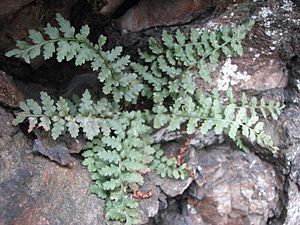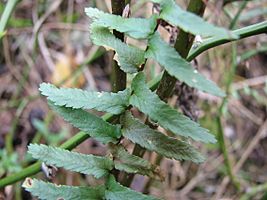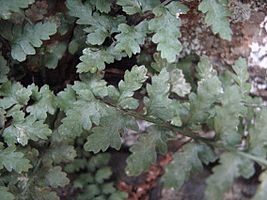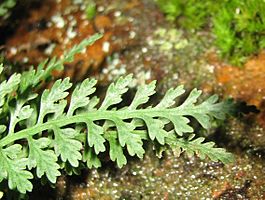Bradley's spleenwort facts for kids
Quick facts for kids Bradley's spleenwort |
|
|---|---|
 |
|
| A mature Asplenium bradleyi growing in a crevice in schist | |
| Conservation status | |
| Scientific classification | |
| Genus: |
Asplenium
|
| Species: |
bradleyi
|
| Synonyms | |
|
|
Asplenium bradleyi, also known as Bradley's spleenwort, is a special type of fern. It's quite rare and grows on rocks in east-central North America. This fern was named after Professor Frank Howe Bradley, who first found it in Tennessee.
You can find Bradley's spleenwort in the Appalachian Mountains, the Ozarks, and the Ouachita Mountains. It likes to grow in small cracks on exposed sandstone cliffs. This fern is a hybrid (a mix) of two other ferns: the mountain spleenwort (Asplenium montanum) and the ebony spleenwort (Asplenium platyneuron).
A. bradleyi formed when a sterile (unable to reproduce) hybrid fern doubled its chromosomes. This made it fertile and able to create new ferns. Scientists believe that today's Bradley's spleenwort ferns came from several different times when this chromosome doubling happened. A. bradleyi can also create new sterile hybrids with other spleenwort ferns.
Bradley's spleenwort doesn't do well in places where other plants grow easily. But it's perfectly suited for the tough conditions of its native cliffs. The soil there is thin and acidic, and there aren't many other plants competing for space. This isolated home on the cliffs helps protect it. However, activities like quarrying (digging for rocks), mining, and rock climbing can harm its habitat.
Contents
What Does Bradley's Spleenwort Look Like?
Bradley's spleenwort is a small fern with dark green leaves, called fronds. These fronds are divided into many small parts. They stay green all year round and grow in clumps.
One key feature is its dark stem, which keeps its color far up into the leaf. Each main leaflet (called a pinna) has a deeply cut lobe at its base. The edges of the pinnae are also toothed. However, these features can vary a bit between different ferns. Some might have rounded edges or less dark color on their stems. Both the fertile (spore-producing) and sterile fronds look the same.
Stems and Leaves
The fern's underground stems, called rhizomes, are short and grow close to the ground. Sometimes they curve upwards, making the fronds grow in a cluster. These rhizomes are thin, about 1 millimeter (0.04 inches) wide. They are covered with dark reddish-brown scales that look like a lattice pattern.
The stalk of the leaf, called the stipe, stands upright. It can be from 1 to 10 centimeters (0.4 to 4 inches) long, sometimes even up to 13 centimeters (5 inches). It's shiny and reddish-brown or purplish-brown. Small brown scales cover the base of the stipe, becoming like hairs closer to the leaf tip.
The main part of the leaf, called the blade, can be oblong (tapering at both ends) or lance-shaped (wider near the base and tapering to a point). It's usually squared off at the bottom and pointed at the top. The blade is typically 2 to 17 centimeters (0.8 to 6.7 inches) long, and 1 to 6 centimeters (0.4 to 2.4 inches) wide.
The blade has 5 to 15 pairs of pinnae (leaflets), but sometimes as few as 3 or as many as 20. These pinnae are deeply lobed or even further divided into smaller parts called pinnules. The lower pinnae have small stalks, while the upper ones do not. The pinnae are usually widest near their base and have a squared-off shape. The lobe closest to the tip of the frond on each pinna is often larger. The pinnae edges are toothed. They range from 6 to 40 millimeters (0.2 to 1.6 inches) long and 3 to 10 millimeters (0.1 to 0.4 inches) wide in the middle of the frond.
Spores and Reproduction
Each fertile pinna has three or more pairs of sori. Sori are small clusters of spore-producing structures. They are 1 to 2 millimeters (0.04 to 0.08 inches) long and are rusty or dark brown. They are found between the edge and the middle vein of the pinnae.
The sori are covered by a thin, white to light tan membrane called an indusium, which has smooth edges. Each sporangium (spore case) holds 64 spores. Bradley's spleenwort has 144 chromosomes, which shows it came from two different parent species combining their chromosomes. It produces spores from June to December.
Different Forms of the Fern
Sometimes, A. bradleyi can look a bit different. Ferns growing in very shady spots might have less color in their stems and look simpler. Some forms have rounded teeth instead of sharp ones. There's even a tiny form found in Illinois, with fronds only about 1 centimeter (0.4 inches) long!
A. bradleyi is most similar to its parent, A. montanum. You can tell them apart because A. bradleyi has toothed pinnae that are less deeply cut. Also, the dark color of its stem extends further up, and its upper pinnae don't have stalks.
- Comparing Bradley's Spleenwort with its Parent Species
How Bradley's Spleenwort Was Discovered
The scientific discovery of A. bradleyi happened in 1871. Frank Howe Bradley collected some ferns near Coal Creek in East Tennessee. He sent them to Daniel Cady Eaton, a botanist, who realized it was a new species. Eaton named it after Bradley in 1873.
For a long time, scientists debated how this fern was related to others. In 1953, Herb Wagner suggested that A. bradleyi was a hybrid of A. montanum and A. platyneuron. His studies in 1954 proved this. He showed that A. bradleyi was an allotetraploid. This means it formed when two different species hybridized to create a sterile fern, and then its chromosomes doubled, making it fertile.
Later studies, using chemical analysis of plant compounds, also supported this idea. They found that A. bradleyi had compounds from both A. montanum and A. platyneuron. This confirmed its hybrid origin.
Its Family Tree and Hybrids
The sterile hybrid of A. montanum and A. platyneuron (the one that looks like A. bradleyi but has infertile spores) was first found in 1972. Even though this sterile hybrid is rare, studies show that A. bradleyi has formed multiple times from different independent hybridizations.
A. bradleyi can also hybridize with other spleenworts. For example, its hybrid with A. pinnatifidum was named A. gravesii in 1918. It can also cross back with its parent species.
Where Bradley's Spleenwort Lives
Bradley's spleenwort is one of the "Appalachian spleenworts." You can find it along the Appalachian Mountains, from New Jersey and Pennsylvania down to Georgia and Alabama. It also appears sometimes along the Ohio Valley and in the Ozarks and Ouachitas (in Missouri, Arkansas, and eastern Oklahoma). Some populations in Maryland and New York are now considered historical, meaning they might not be there anymore. It's scattered in the Appalachians but more common in the Ozarks and Ouachitas.
Protecting Bradley's Spleenwort
Asplenium bradleyi grows on steep, acidic rocks, usually between 0 and 1000 meters (0 to 3,280 feet) high. Sandstone is a common rock it grows on, but it can also be found on schist, gneiss, or granite. The soil formed from these rocks needs to be acidic (pH 3.5–5.0) for the fern to thrive. It usually grows tightly in cracks in exposed rock or cliff faces.
These tiny spaces are too small for most other plants, except for a few other spleenworts. Some mosses and lichens might also live there. The soil in these cracks is a mix of acidic sand from the rock and decaying plant material. The cracks are often moist in winter and spring, but drier in summer. Bradley's spleenwort is very good at living in this tough environment. It doesn't compete well with other plants in richer soils.
The fact that it grows in hard-to-reach places helps protect A. bradleyi. However, quarrying and strip mining (digging up the land) can threaten the sandstone cliffs where it lives. Rock climbers and plant collectors have also harmed some populations. Pollution from the top of cliffs can affect them. Also, too much shade from growing trees, invasive vines covering the cliffs, or piles of wood from logging can harm the ferns.
Bradley's spleenwort is listed as an endangered species in Illinois, Indiana, New Jersey, and Pennsylvania. It's considered threatened in Ohio. The Acadia Cliffs State Nature Preserve in Ohio, created in 1994, protects the only known population of A. bradleyi in that state.
Images for kids
-
A mature Asplenium bradleyi growing in a crevice in schist






